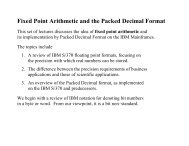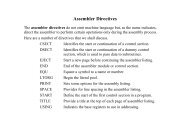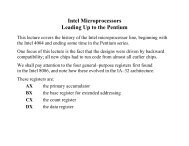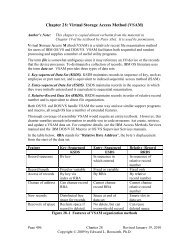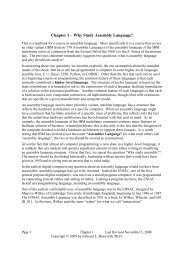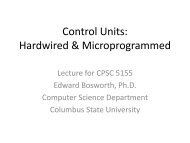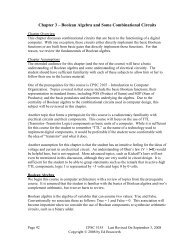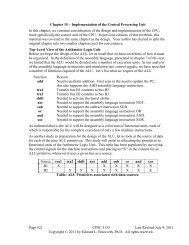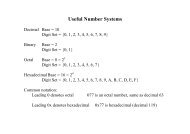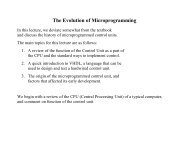PDF Version - Edwardbosworth.com
PDF Version - Edwardbosworth.com
PDF Version - Edwardbosworth.com
Create successful ePaper yourself
Turn your PDF publications into a flip-book with our unique Google optimized e-Paper software.
S/370 Assembler Language Binary Integer Data<br />
Storing Register Values: ST, STH, and STM<br />
ST (Store Full Word) is a type RX instruction, with formatST R1,D2(X2,B2).<br />
STH (Store Half Word) is a type RX instruction, with formatSTH R1,D2(X2,B2).<br />
STM (Store Multiple) is a type RS instruction, with formatSTM R1,R3,D2(B2).<br />
The ST instruction stores the full–word contents of the register, specified in the<br />
first operand, into the full word at the address specified by the second operand.<br />
The STH instruction stores the rightmost 16 bits of the register specified by the<br />
first operand into the half word at the address specified by the second operand.<br />
For STM (Store Multiple Registers), the first two operands specify a range of<br />
registers to be stored. Remember that the register numbers “wrap around”<br />
STM R7,R10,X2<br />
STM R10,R7,X4<br />
STORE THE FOUR REGISTERS R7,R8,R9,AND R10<br />
INTO FOUR FULL-WORDS BEGINNING AT X2<br />
STORE THE 14 REGISTERS R10 THROUGH R7<br />
(ALL BUT R8 AND R9) INTO 14 FULL-WORDS<br />
While each of these instructions is quite similar to its load register partner, we shall<br />
spend a bit of time discussing the instructions. After all, this is a textbook.<br />
ST: Store Fullword<br />
The ST (Store Full Word) is a type RX instruction, with formatST R1,D2(X2,B2)<br />
and opcodeX‘50’. The object code format is as follows:<br />
Type Bytes Operands 1 2 3 4<br />
RX 4 R1,D2(X2,B2) X‘50’ R 1 X 2 B 2 D 2 D 2 D 2<br />
The first operand specifies any general–purpose register. This is indicated by the first<br />
hexadecimal digit in the second byte of the object code.<br />
The second operand references a full–word in storage, usually aligned on a full–word<br />
boundary. The address of this second word is <strong>com</strong>puted from the standard base/displacement<br />
form (B 2 D 2 D 2 D 2 in bytes 3 and 4) with an index register (the second hexadecimal digit in<br />
byte 2). Here is a template for the instruction: ST Reg,Full_Word<br />
Here are some examples of <strong>com</strong>mon usage. Other examples will be discussed later.<br />
Suppose that R3 contains the decimal value 163840, which isX‘0002 8000’.<br />
ST1 ST R3,F1<br />
ST2 ST R3,H1 NOTE THE TYPE MISMATCH.<br />
F1 DC X‘0000 0000’<br />
H1 DC X‘0000’<br />
H2 DC X‘0000’<br />
The instruction at addressST1 works as advertised, storing the register value into the<br />
fullword at the given address. The instruction at addressST2 is almost certainly a mistake.<br />
The register value is stored into the four bytes beginning at addressH1. HalfwordH1 is set<br />
to the valueX‘0002’ and halfwordH2 is set to the valueX‘8000’.<br />
Page 232 Chapter 12 Last Revised July 6, 2009<br />
Copyright © 2009 by Edward L. Bosworth, Ph.D.



